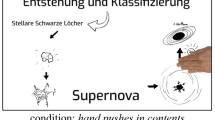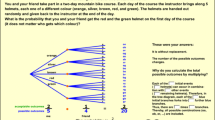Abstract
As an instructional material, 3D instructions afford people to learn procedural-manipulative tasks. Observing and emulating motions presented in 3D animations is important in learning contexts. This study examined the effects of visual cueing in an effort to identify the optimal way to present information in a 3D virtual environment. While previous studies have found that animations are more effective than static images for learning procedural-manipulative tasks, the transient nature of dynamic visualizations might create an unnecessary cognitive load on learners. To compensate strategically for the lack of permanency, this study suggests combining dynamic and static visualizations into one medium by adding transparent static images (visual cueing) to an animation. A between-subjects experiment was conducted to examine the effects of visual cueing on cognitive load and learning outcomes. The study found that the hybrid of dynamic and static visualizations was beneficial for reducing cognitive load, although it did not improve learning outcomes. The results suggest a design strategy for improving the effectiveness of 3D instructional animations. The findings are broadly applicable to numerous learning contexts, such as virtual reality storytelling, augmented reality games, and diverse gamification services.





Similar content being viewed by others
References
Arguel, A., & Jamet, E. (2009). Using video and static pictures to improve learning of procedural contents. Computers in Human Behavior, 25(2), 354–359.
Ayres, P., Marcus, N., Chan, C., & Qian, N. (2009). Learning hand manipulative tasks: When instructional animations are superior to equivalent static representations. Computers in Human Behavior, 25(2), 348–353.
Ayres, P., & Paas, F. (2007). Making instructional animations more effective: A cognitive load approach. Applied Cognitive Psychology, 21(6), 695–700.
Ayres, P., & Sweller, J. (2005). The split-attention principle in multimedia learning. The Cambridge Handbook of Multimedia Learning, 2, 135–146.
Berry, D., & Dienes, Z. P. (1993). Implicit learning: Theoretical and empirical issues. New York, NY: Psychology Press.
Brunken, R., Plass, J. L., & Leutner, D. (2003). Direct measurement of cognitive load in multimedia learning. Educational Psychologist, 38(1), 53–61.
Castro-Alonso, J. C., Ayres, P., & Paas, F. (2015). Animations showing Lego manipulative tasks: Three potential moderators of effectiveness. Computers & Education, 85, 1–13.
Chandler, P., & Sweller, J. (1991). Cognitive load theory and the format of instruction. Cognition and Instruction, 8(4), 293–332.
De Koning, B. B., Tabbers, H. K., Rikers, R. M., & Paas, F. (2009). Towards a framework for attention cueing in instructional animations: Guidelines for research and design. Educational Psychology Review, 21(2), 113–140.
De Koning, B. B., Tabbers, H. K., Rikers, R. M., & Paas, F. (2011). Attention cueing in an instructional animation: The role of presentation speed. Computers in Human Behavior, 27(1), 41–45.
Garland, T. B., & Sanchez, C. A. (2013). Rotational perspective and learning procedural tasks from dynamic media. Computers & Education, 69, 31–37.
Hart, S. G., & Staveland, L. E. (1988). Development of NASA-TLX (Task Load Index). Advances in Psychology, 52, 139–183.
Hegarty, M. (2004). Dynamic visualizations and learning: Getting to the difficult questions. Learning and Instruction, 14(3), 343–351.
Höffler, T. N., & Leutner, D. (2007). Instructional animation versus static pictures: A meta-analysis. Learning and Instruction, 17(6), 722–738.
Hwang, Y., & Shin, D. (2018). The roles of visual experience in enhancing user performance in virtual environments. Social Behavior and Personality, 46(1), 11–24. https://doi.org/10.2224/sbp.6500.
Mayer, R. E. (2010). Unique contributions of eye-tracking research to the study of learning with graphics. Learning and Instruction, 20(2), 167–171.
Mayer, R. E., & Moreno, R. (2002). Animation as an aid to multimedia learning. Educational Psychology Review, 14(1), 87–99.
Mayer, R. E., & Moreno, R. (2003). Nine ways to reduce cognitive load in multimedia learning. Educational Psychologist, 38(1), 43–52.
Paas, F., & Sweller, J. (2012). An evolutionary upgrade of cognitive load theory: Using the human motor system and collaboration to support the learning of complex cognitive tasks. Educational Psychology Review, 24(1), 27–45.
Paas, F., Tuovinen, J., Tabbers, H., & van Gerven, P. W. M. (2003). Cognitive load measurement as a means to advance cognitive load theory. Educational Psychologist, 38, 63–71.
Ryle, G. (2009). The concept of mind. New York, NY: Routledge.
Shin, D. (2012). 3DTV as a social platform for communication and interaction. Information Technology and People, 25(1), 55–80.
Shin, D. (2017). The role of affordance in the experience of virtual reality learning. Telematics and Informatics, 34(8), 1826–1836. https://doi.org/10.1016/j.tele.2017.05.013.
Shin, D., An, H., & Kim, J. (2016a). How the second screens change the way people interact and learn: The effects of second screen use on information processing. Interactive Learning Environment, 24(8), 2058–2079. https://doi.org/10.1080/10494820.2015.1076851.
Shin, D., Choi, M., Kim, J., & Lee, J. (2016b). Interaction, engagement, and perceived interactivity in single-handed interaction. Internet Research, 26(5), 1134–1157. https://doi.org/10.1108/IntR-12-2014-0312.
Shin, D., & Chung, K. (2017). The effects of input modality and story-based knowledge on users’ game experience. Computers in Human Behavior, 68, 180–189. https://doi.org/10.1016/j.chb.2016.11.030.
Tversky, B., Morrison, J. B., & Betrancourt, M. (2002). Animation: Can it facilitate? International Journal of Human–Computer Studies, 57(4), 247–262.
Van Gog, T., Paas, F., Marcus, N., Ayres, P., & Sweller, J. (2009). The mirror neuron system and observational learning: Implications for the effectiveness of dynamic visualizations. Educational Psychology Review, 21(1), 21–30.
Wong, A., Marcus, N., Ayres, P., Smith, L., Cooper, G. A., Paas, F., et al. (2009). Instructional animations can be superior to statics when learning human motor skills. Computers in Human Behavior, 25(2), 339–347.
Author information
Authors and Affiliations
Corresponding author
Ethics declarations
Conflict of interest
The author declares that there is no conflict of interest regarding the publication of this article.
Additional information
Publisher's Note
Springer Nature remains neutral with regard to jurisdictional claims in published maps and institutional affiliations.
Rights and permissions
About this article
Cite this article
Shin, D., Park, S. 3D learning spaces and activities fostering users’ learning, acceptance, and creativity. J Comput High Educ 31, 210–228 (2019). https://doi.org/10.1007/s12528-019-09205-2
Published:
Issue Date:
DOI: https://doi.org/10.1007/s12528-019-09205-2




